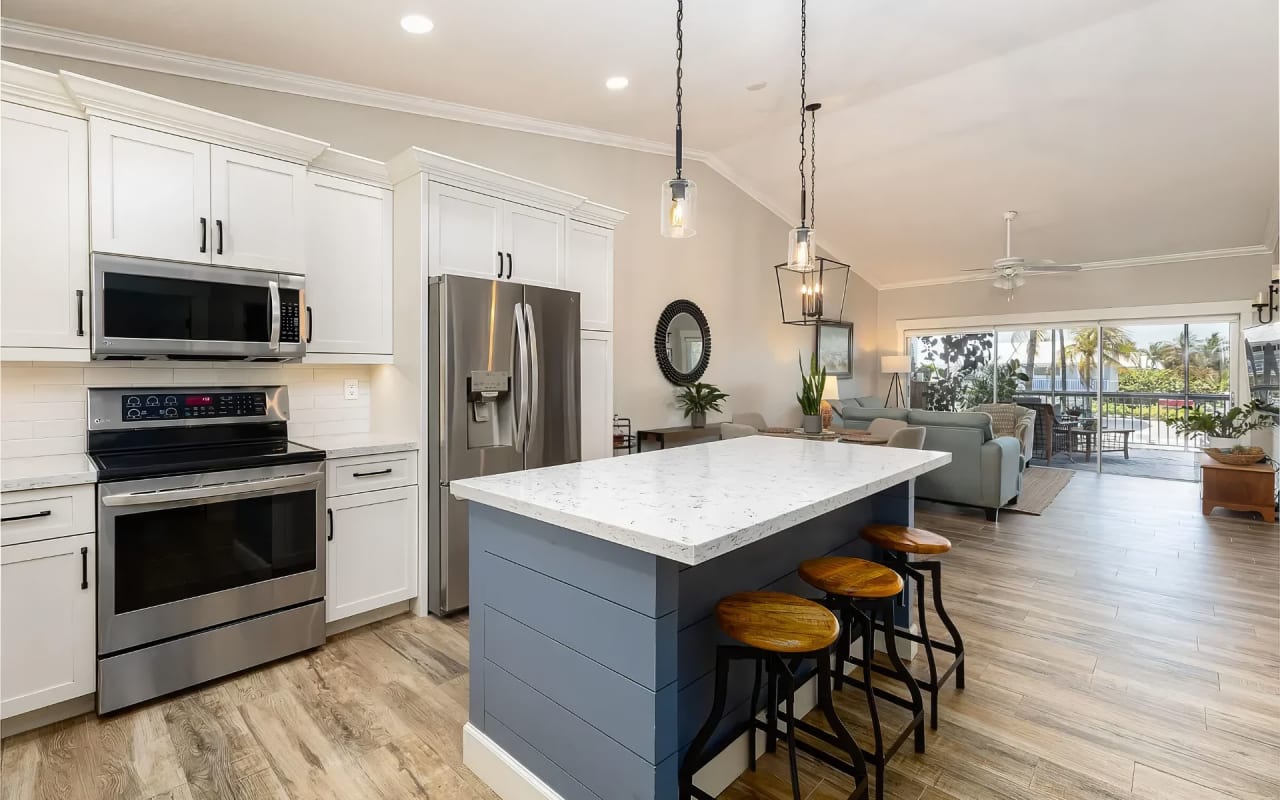Purchasing a new home stands as one of life's most thrilling experiences. If you're akin to the majority of homebuyers, you might already be envisioning furniture placements and decor even before the ink dries on your offer letter. However, it's essential to exercise caution and patience before making significant purchases. Large expenses or new lines of credit can potentially impact your credit score and, consequently, affect your mortgage terms.¹ Additionally, moving and closing costs can accumulate swiftly, necessitating strategic planning with your remaining budget.¹
But fear not! There are numerous ways to save on essential household items, and we've gathered some of our top recommendations to share with you.
PRIORITIZE WHAT YOU TRULY NEED BEFORE YOU BEGIN SHOPPING
The national average cost to furnish a new house, according to Home Advisor, is $16,000, but this figure can escalate quickly.² Hence, it's prudent to start by thoroughly assessing what you already possess and what you genuinely need to establish your life in the new dwelling. Here are steps to help prioritize your purchases and manage your expenses:
- Create a comprehensive list of everything you need, contemplating each room's necessities. For instance, your list could range from a mattress to blackout curtains for the primary bedroom.
- Conduct an inventory of items you already possess and check off what you won't need in your new home.
- Categorize the remaining items into three groups: immediate necessities (such as a mattress), items you desire in the near future (like a coffee table), and pieces that can wait (e.g., an area rug).
- Calculate your budget. Determine the available funds for immediate purchases post-closing and research the priority list items to gauge their affordability.
- Take your time. Utilize existing items in your new space without feeling obliged to retain them permanently. Some items can serve you for a year or two until your finances recover from the home purchasing costs.¹
Before embarking on shopping, ascertain which appliances and fixtures are included in your home purchase. We can apprise you of the standard contract terms when making an initial offer and note any additional items you may wish to request.
TIME YOUR PURCHASES TO MAXIMIZE SEASONAL SALES
Certain home items tend to go on sale predictably during specific times of the year. Making purchases during these periods can yield significant savings. Here are optimal times to buy household essentials:³,⁴
- Bedding and linens: January
- TVs: Black Friday/Cyber Monday, and late January (before the Super Bowl)
- Furniture: February, August, Black Friday, Memorial Day, and Labor Day
- Large appliances: Labor Day through October
- Small kitchen appliances: May
- Mattresses: Holiday weekends, especially Memorial Day, Labor Day, and 4th of July
- Vacuum cleaners: April
- Tools: June
- Outdoor furniture: August through October
Typically, holiday weekends and events like Black Friday and Cyber Monday present excellent opportunities to find deals. For seasonal items like patio furniture or holiday decorations, waiting until the end of the season often results in better deals.
EXPLORE ALTERNATIVE SHOPPING SOURCES
If you can't wait for sales, consider looking beyond traditional stores. There are several surprising places where you can discover fantastic furniture and houseware deals:
- Explore overstock and liquidation stores where items unsold by other retailers are offered at steep discounts.⁵
- Consider private membership or warehouse stores such as Costco and Sam’s Club, known for offering great deals on home goods. If you're not a member, consider asking friends or family for assistance.
- Look for open-box deals from retailers like Wayfair and Amazon Warehouse, as returned items that haven’t been used significantly are sold at a discount. You can also check local retailers for similar offers.
- Consider scratch-and-dent appliances, sold at reduced prices due to minor damages to the external packaging. However, ensure to inspect these items thoroughly and inquire about available warranties.⁶
- Expand your search for window treatments by exploring off-the-shelf options in standard sizes or ordering online from discount suppliers if custom sizes or materials are needed.
- Explore secondhand options through thrift stores, garage sales, and online platforms like Facebook Marketplace, NextDoor, and Craigslist. Additionally, consider joining local Freecycle or “Buy Nothing” groups, where participants offer items they no longer need for free to other members.⁷,⁸
DON'T HESITATE TO NEGOTIATE FOR BETTER DEALS
Many aren't aware that prices for home goods, including furniture and appliances, are often negotiable. While negotiating can be daunting, it's a common practice, especially in independently-owned stores. Here are some tips:⁹,¹⁰
- Before shopping, compare prices elsewhere to leverage potential price matches offered by many retailers.
- Ask store associates or managers for the best available price. They might provide additional discounts or offer coupons.
- Consider paying in cash and inquire about potential cash discounts.
- Call ahead to inquire about available discounts for specific groups like active military, veterans, teachers, first responders, or senior citizens.
- Point out any imperfections in items to the sales staff, which could lead to a price reduction.
- Ask about floor models, which stores often offer at lower prices even if they're in nearly new condition.
After negotiating, don’t forget to ask for free or discounted delivery, as some stores offer this for larger purchases.
MAXIMIZE REWARD PROGRAMS AND COUPONS
Every saving counts when managing a budget, so it's worthwhile to explore and utilize reward programs and discounts:
- Sign up for a change of address kit with the United States Postal Service to receive valuable coupons along with forwarding mail to your new address.¹¹
- Subscribe to your favorite retailers' email lists and follow them on social media to stay updated on discounts and sales.
- Explore loyalty programs, which often come with introductory coupons, especially when making substantial purchases or buying multiple items from a store.
- Carefully consider store credit cards for potential discounts but ensure you only charge what you can immediately pay off to avoid interest. Additionally, refrain from opening new lines of credit until after your home purchase to prevent affecting your credit score.
- Enroll in coupon and cashback programs when shopping online to discover discounts and receive cash back on purchases.
Additionally, consider setting up a housewarming registry as it can serve as a tool for sharing needed items with family and friends, sometimes offering a percentage off for purchasing unpurchased registry items.
GET CREATIVE
To maintain a unique home style and save money, consider reimagining and repurposing your existing furniture for your new space. Here are some innovative strategies:
- Repurpose your existing items for different functions, such as using an old dresser as a TV stand or repurposing a mismatched dining chair in your home office.
- Consider upgrading existing furniture by refinishing, repainting, or changing hardware rather than replacing items.
- Instead of purchasing new furniture, consider reupholstering tired-looking but sturdy sofas or chairs with new fabric.
- Explore do-it-yourself projects for simple items like headboards, ensuring you have the necessary tools and guidance for the task. Alternatively, if DIY isn't your forte, consider seeking professional help.
I'M HERE TO ASSIST
Understanding the challenges of budgeting for a new home, I aim to simplify the process for you. If you're contemplating a home purchase, I can provide guidance on establishing a realistic budget and help evaluate your options. I also offer insights into financial considerations and programs.
Reach out for a free consultation.
The above references an opinion and is for informational purposes only. It is not intended to be financial, legal, or tax advice. Consult the appropriate professionals for advice regarding your individual needs.
Sources:
- Bankrate –
https://www.bankrate.com/mortgages/avoid-mortgage-closing-missteps/ - Furniture Bank –
https://www.furniturebank.org/how-much-does-it-cost-to-furnish-an-apartment/ - US News –
https://money.usnews.com/money/personal-finance/saving-and-budgeting/articles/the-best-time-of-year-to-buy-everything - NerdWallet –
https://www.nerdwallet.com/article/finance/wht-to-buy-every-month - Business Insider –
https://www.businessinsider.com/personal-finance/strategies-to-save-money-on-furniture-for-my-new-home?r=US&IR=T - CNET –
https://www.cnet.com/home/kitchen-and-household/buy-scratch-and-dent-appliances/ - Real Simple –
https://www.realsimple.com/home-organizing/green-living/buy-nothing-groups - Freecycle –
https://www.freecycle.org/ - Consumer Reports –
https://www.consumerreports.org/cro/magazine/2013/08/how-to-bargain/index.htm - Realtor.com –
https://www.realtor.com/advice/home-improvement/furniture-stores-money-saving-tricks/ - The Krazy Coupon Lady –
https://thekrazycouponlady.com/tips/money/usps-moving-coupons - Taste of Home –
https://www.tasteofhome.com/article/housewarming-registry/






